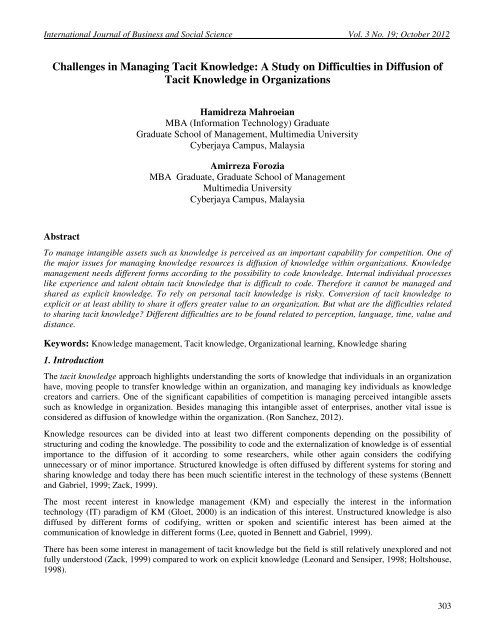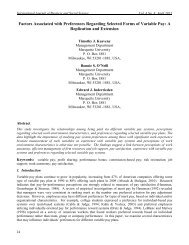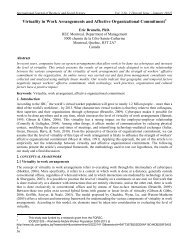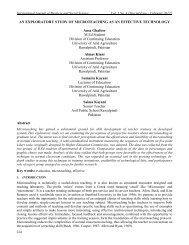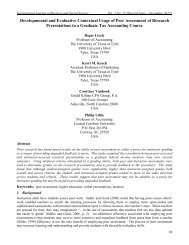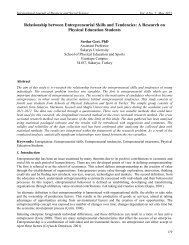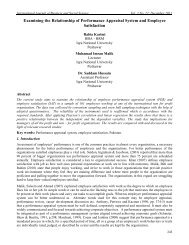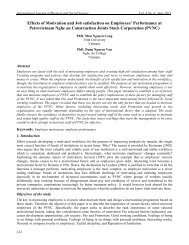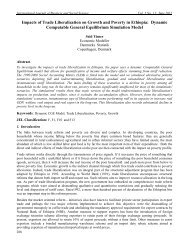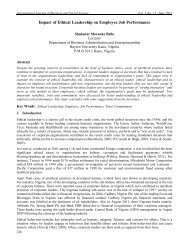Challenges in Managing Tacit Knowledge - International Journal of ...
Challenges in Managing Tacit Knowledge - International Journal of ...
Challenges in Managing Tacit Knowledge - International Journal of ...
Create successful ePaper yourself
Turn your PDF publications into a flip-book with our unique Google optimized e-Paper software.
<strong>International</strong> <strong>Journal</strong> <strong>of</strong> Bus<strong>in</strong>ess and Social Science Vol. 3 No. 19; October 2012<br />
<strong>Challenges</strong> <strong>in</strong> Manag<strong>in</strong>g <strong>Tacit</strong> <strong>Knowledge</strong>: A Study on Difficulties <strong>in</strong> Diffusion <strong>of</strong><br />
<strong>Tacit</strong> <strong>Knowledge</strong> <strong>in</strong> Organizations<br />
Hamidreza Mahroeian<br />
MBA (Information Technology) Graduate<br />
Graduate School <strong>of</strong> Management, Multimedia University<br />
Cyberjaya Campus, Malaysia<br />
Amirreza Forozia<br />
MBA Graduate, Graduate School <strong>of</strong> Management<br />
Multimedia University<br />
Cyberjaya Campus, Malaysia<br />
Abstract<br />
To manage <strong>in</strong>tangible assets such as knowledge is perceived as an important capability for competition. One <strong>of</strong><br />
the major issues for manag<strong>in</strong>g knowledge resources is diffusion <strong>of</strong> knowledge with<strong>in</strong> organizations. <strong>Knowledge</strong><br />
management needs different forms accord<strong>in</strong>g to the possibility to code knowledge. Internal <strong>in</strong>dividual processes<br />
like experience and talent obta<strong>in</strong> tacit knowledge that is difficult to code. Therefore it cannot be managed and<br />
shared as explicit knowledge. To rely on personal tacit knowledge is risky. Conversion <strong>of</strong> tacit knowledge to<br />
explicit or at least ability to share it <strong>of</strong>fers greater value to an organization. But what are the difficulties related<br />
to shar<strong>in</strong>g tacit knowledge? Different difficulties are to be found related to perception, language, time, value and<br />
distance.<br />
Keywords: <strong>Knowledge</strong> management, <strong>Tacit</strong> knowledge, Organizational learn<strong>in</strong>g, <strong>Knowledge</strong> shar<strong>in</strong>g<br />
1. Introduction<br />
The tacit knowledge approach highlights understand<strong>in</strong>g the sorts <strong>of</strong> knowledge that <strong>in</strong>dividuals <strong>in</strong> an organization<br />
have, mov<strong>in</strong>g people to transfer knowledge with<strong>in</strong> an organization, and manag<strong>in</strong>g key <strong>in</strong>dividuals as knowledge<br />
creators and carriers. One <strong>of</strong> the significant capabilities <strong>of</strong> competition is manag<strong>in</strong>g perceived <strong>in</strong>tangible assets<br />
such as knowledge <strong>in</strong> organization. Besides manag<strong>in</strong>g this <strong>in</strong>tangible asset <strong>of</strong> enterprises, another vital issue is<br />
considered as diffusion <strong>of</strong> knowledge with<strong>in</strong> the organization. (Ron Sanchez, 2012).<br />
<strong>Knowledge</strong> resources can be divided <strong>in</strong>to at least two different components depend<strong>in</strong>g on the possibility <strong>of</strong><br />
structur<strong>in</strong>g and cod<strong>in</strong>g the knowledge. The possibility to code and the externalization <strong>of</strong> knowledge is <strong>of</strong> essential<br />
importance to the diffusion <strong>of</strong> it accord<strong>in</strong>g to some researchers, while other aga<strong>in</strong> considers the codify<strong>in</strong>g<br />
unnecessary or <strong>of</strong> m<strong>in</strong>or importance. Structured knowledge is <strong>of</strong>ten diffused by different systems for stor<strong>in</strong>g and<br />
shar<strong>in</strong>g knowledge and today there has been much scientific <strong>in</strong>terest <strong>in</strong> the technology <strong>of</strong> these systems (Bennett<br />
and Gabriel, 1999; Zack, 1999).<br />
The most recent <strong>in</strong>terest <strong>in</strong> knowledge management (KM) and especially the <strong>in</strong>terest <strong>in</strong> the <strong>in</strong>formation<br />
technology (IT) paradigm <strong>of</strong> KM (Gloet, 2000) is an <strong>in</strong>dication <strong>of</strong> this <strong>in</strong>terest. Unstructured knowledge is also<br />
diffused by different forms <strong>of</strong> codify<strong>in</strong>g, written or spoken and scientific <strong>in</strong>terest has been aimed at the<br />
communication <strong>of</strong> knowledge <strong>in</strong> different forms (Lee, quoted <strong>in</strong> Bennett and Gabriel, 1999).<br />
There has been some <strong>in</strong>terest <strong>in</strong> management <strong>of</strong> tacit knowledge but the field is still relatively unexplored and not<br />
fully understood (Zack, 1999) compared to work on explicit knowledge (Leonard and Sensiper, 1998; Holtshouse,<br />
1998).<br />
303
© Centre for Promot<strong>in</strong>g Ideas, USA www.ijbssnet.com<br />
S<strong>in</strong>ce tacit knowledge is seen as critical to the success <strong>of</strong> groups and organizations (Melissa Peet, 2011) recent<br />
scholarly work has focused on how organizations can create conditions that enable knowledge creation, i.e. ‘‘the<br />
process <strong>of</strong> mak<strong>in</strong>g available and amplify<strong>in</strong>g knowledge created by <strong>in</strong>dividuals [. . .] and connect<strong>in</strong>g it to an<br />
organization’s knowledge system’’ (Nonaka et al., 2006, pp. 1179-1193).<br />
The <strong>in</strong>terest <strong>in</strong> diffusion <strong>of</strong> tacit knowledge has been rare but is <strong>in</strong>creas<strong>in</strong>g (Augier and Vendelo, 1999).<br />
A deeper understand<strong>in</strong>g <strong>of</strong> externalization and diffusion <strong>of</strong> tacit knowledge must be achieved for organizations to<br />
unleash the resources <strong>of</strong> tacit knowledge.<br />
Understand<strong>in</strong>g the difficulties <strong>of</strong> tacit knowledge and its challenges <strong>in</strong> manag<strong>in</strong>g tacit knowledge with<strong>in</strong><br />
organization could be a means for such deeper understand<strong>in</strong>g.<br />
What are the difficulties related to shar<strong>in</strong>g tacit knowledge? The study sets a theoretical foundation for an<br />
empirical analysis <strong>of</strong> the field.<br />
2. <strong>Tacit</strong> knowledge<br />
The most important feature <strong>of</strong> the tacit knowledge approach is the fundamental pr<strong>in</strong>ciple that knowledge is<br />
basically <strong>in</strong>dividual <strong>in</strong> nature and is consequently complicated to extract from the heads <strong>of</strong> <strong>in</strong>dividuals. (Ron<br />
Sanchez, 2012).The tacitness <strong>of</strong> knowledge is tough to estimate but knowledge can be observed <strong>in</strong> a range where<br />
at one extreme end we f<strong>in</strong>d the entirely tacit and unconscious knowledge and at the other end the completely<br />
explicit, structured and coded knowledge (Polanyi, quoted <strong>in</strong> Leonard and Sensiper, 1998).<br />
In such a dualist framework tacit and explicit is juxtaposed or co-exist<strong>in</strong>g <strong>in</strong> a synergetic relationship (Gill, 2000).<br />
In work<strong>in</strong>g life we f<strong>in</strong>d many epitomes <strong>of</strong> tacit knowledge such as <strong>in</strong>tuition, rule-<strong>of</strong>-thumb, gut feel<strong>in</strong>g and<br />
personal skills. These can be classified <strong>in</strong>to two dimensions, the technical and the cognitive dimension. The<br />
technical dimension encompasses <strong>in</strong>formation and expertise <strong>in</strong> relation to ``know-how'' and the cognitive<br />
dimension consists <strong>of</strong> mental models, beliefs and values (Gore and Gore, 1999). Individuals are the primary<br />
repositories <strong>of</strong> tacit knowledge that due to its transparent uniqueness is not easy to communicate. We can<br />
understand tacit knowledge as when one has emancipated oneself from the technical formulas for action. It is for<br />
example to be able to cook without a recipe or to have an <strong>in</strong>tuitive feel<strong>in</strong>g <strong>of</strong> the right decision.<br />
<strong>Tacit</strong> knowledge is achieved by <strong>in</strong>ternal <strong>in</strong>dividual processes like experience, reflection, <strong>in</strong>ternalization or<br />
<strong>in</strong>dividual talents. As a result it cannot be managed and taught <strong>in</strong> the same mode as knowledge which is explicit.<br />
<strong>Tacit</strong> knowledge is mostly stored only <strong>in</strong> human be<strong>in</strong>gs, while explicit k<strong>in</strong>d <strong>of</strong> knowledge can be stored <strong>in</strong> a<br />
technological or mechanical way, like <strong>in</strong> <strong>in</strong>formation systems or handbooks. <strong>Tacit</strong> knowledge is technical or<br />
cognitive and is made up <strong>of</strong> mental models, values, beliefs, perceptions, <strong>in</strong>sights and assumptions (Elizabeth A.<br />
Smith, 2001)<br />
<strong>Tacit</strong> knowledge cannot be given <strong>in</strong> lectures and it cannot be found <strong>in</strong> databases, textbooks, manuals or <strong>in</strong>ternal<br />
newsletters for diffusion. It has to be <strong>in</strong>ternalized <strong>in</strong> the human body and soul. Different methods like<br />
apprenticeship, direct <strong>in</strong>teraction, network<strong>in</strong>g and action learn<strong>in</strong>g that <strong>in</strong>clude face-to-face social <strong>in</strong>teraction and<br />
practical experiences are more suitable for support<strong>in</strong>g the shar<strong>in</strong>g <strong>of</strong> tacit knowledge. To rely on personal tacit<br />
knowledge <strong>in</strong> organizations is risky. Conversion <strong>of</strong> tacit knowledge to explicit or at least ability to share it <strong>of</strong>fers<br />
greater value to the organization.<br />
3. <strong>Knowledge</strong> assets <strong>in</strong> organizations<br />
The def<strong>in</strong>ition <strong>of</strong> organizational knowledge is yet another concept that has very little consensus with<strong>in</strong> literature.<br />
Variations <strong>in</strong>clude the extent to which the knowledge is spread with<strong>in</strong> the organization, as well as the actual<br />
make-up <strong>of</strong> this knowledge. Hatch (2010) def<strong>in</strong>es it as: "When group knowledge from several subunits or groups<br />
is comb<strong>in</strong>ed and used to create new knowledge, the result<strong>in</strong>g tacit and explicit knowledge can be called<br />
organizational knowledge." Others present a broader perspective: "<strong>in</strong>dividual knowledge, shared knowledge, and<br />
objectified knowledge are different aspects or views <strong>of</strong> organizational knowledge" (Ek<strong>in</strong>ge & Lennartsson 2000).<br />
As always, texts emphasiz<strong>in</strong>g an IT based outlook once aga<strong>in</strong> <strong>of</strong>fer shallower, <strong>in</strong>formation-based def<strong>in</strong>itions, e.g.<br />
Virvou & Nakamura 2008, "Information <strong>in</strong>ternalized by means <strong>of</strong> research, study or experience that has value to<br />
the organization".<br />
304
<strong>International</strong> <strong>Journal</strong> <strong>of</strong> Bus<strong>in</strong>ess and Social Science Vol. 3 No. 19; October 2012<br />
Different levels <strong>of</strong> knowledge, regard<strong>in</strong>g the possibility to codify, can be recognized <strong>in</strong> organizations' knowledge<br />
resources (Gore and Gore, 1999). The easiest to code is structured knowledge, <strong>in</strong> for example databases and<br />
<strong>in</strong>struction books. Unstructured knowledge found <strong>in</strong>, for <strong>in</strong>stance, reports or discussions is possible to code but<br />
this is not always done. The hardest to code is tacit knowledge, which is the most transparent and subjective form<br />
<strong>of</strong> knowledge (Augier and Vendelo, 1999).<br />
Organizations' knowledge resources and assets have pert<strong>in</strong>ently been expressed as an iceberg. The structured,<br />
explicit knowledge is the visible top <strong>of</strong> the iceberg. This part <strong>of</strong> the knowledge resource is easy to f<strong>in</strong>d and<br />
recognize and therefore also easier to share. This is also done <strong>in</strong> organization through different forms <strong>of</strong><br />
technological and pedagogical methods. Beneath the surface, <strong>in</strong>visible and hard to communicate, is a momentous<br />
part <strong>of</strong> the iceberg. This hidden part applies to tacit knowledge resources <strong>in</strong> organizations. We know more than<br />
we can express (Polanyi, 1966) and therefore this part <strong>of</strong> the knowledge resource can be more difficult to share.<br />
4. Influence <strong>of</strong> tacit knowledge<br />
<strong>Tacit</strong> knowledge can also be seen as the ic<strong>in</strong>g on the cake. Structured and explicit knowledge is <strong>of</strong> importance but<br />
to achieve excellence <strong>in</strong> a job one has to master higher levels <strong>of</strong> knowledge, the unstructured and <strong>in</strong>tangible tacit<br />
knowledge. Explicit knowledge is for everyone to f<strong>in</strong>d and use but tacit knowledge separates the masters from the<br />
common (Lawson and Lorenzi, 1999). An organization's core competency is more than the explicit knowledge <strong>of</strong><br />
``know-what''; it requires the more tacit ``know-how'' to put ``know-what'' <strong>in</strong>to practice (Brown and Duguid,<br />
1998).<br />
<strong>Tacit</strong> knowledge makes work go smoothly, it <strong>in</strong>creases the quality <strong>of</strong> the work and it <strong>of</strong>ten characterizes a master<br />
<strong>of</strong> his/her pr<strong>of</strong>ession.<br />
The efficiency <strong>of</strong> mak<strong>in</strong>g decisions, serv<strong>in</strong>g customers or produc<strong>in</strong>g is improved by the use <strong>of</strong> tacit knowledge.<br />
Also the accuracy <strong>of</strong> task performance is improved by the use <strong>of</strong> tacit knowledge (Brockmann and Anthony,<br />
1998).<br />
In the world <strong>of</strong> today where the significance <strong>of</strong> time is <strong>in</strong>creased while the length <strong>of</strong> it is decreased, experts can<br />
achieve major time sav<strong>in</strong>g improvements by us<strong>in</strong>g tacit knowledge. Even if coded knowledge is easier to diffuse<br />
the role <strong>of</strong> tacit knowledge is <strong>of</strong>ten essential for be<strong>in</strong>g able to use coded knowledge. Coded knowledge can even<br />
be unusable without the augmentation <strong>of</strong> tacit knowledge (Shariq, 1999; Brown and Duguid, 1998). One can learn<br />
the importance <strong>of</strong> service quality by ead<strong>in</strong>g textbooks but not learn a ``smil<strong>in</strong>g attitude'' by read<strong>in</strong>g about it.<br />
5. Shar<strong>in</strong>g tacit knowledge with<strong>in</strong> organizations<br />
The characteristic <strong>of</strong> tacit knowledge is the difficulty <strong>in</strong> cod<strong>in</strong>g it so as to be shared. There can be found two<br />
different schools regard<strong>in</strong>g externalization and codification <strong>of</strong> tacit knowledge. One that believes that tacit<br />
knowledge must be made explicit for shar<strong>in</strong>g and another that regards tacit knowledge as always be<strong>in</strong>g tacit.<br />
One example <strong>of</strong> the first is Nonaka and Konno (1998) who have created a model <strong>of</strong> knowledge creation <strong>in</strong> the<br />
SECI-model. This model also concerns transfer <strong>of</strong> tacit knowledge. They assert that the process <strong>in</strong>clude four<br />
modes, socialization, externalization, comb<strong>in</strong>ation, and <strong>in</strong>ternalization <strong>in</strong> an ongo<strong>in</strong>g circular movement.<br />
Socialization <strong>in</strong>cludes the essential social <strong>in</strong>teraction that is needed to learn new knowledge. In this mode tacit<br />
knowledge is converted to tacit knowledge. As many scientists claim learn<strong>in</strong>g is a social action and <strong>in</strong>teraction is<br />
needed to be able to learn (see for example Argyris and SchoÈn, 1978). Learn<strong>in</strong>g is achieved for example by<br />
model<strong>in</strong>g or team-work. For knowledge to be shared it first has to be made conscious and articulated; an<br />
externalization must occur. In the second mode this externalization converts tacit knowledge to explicit. Some<br />
understandable forms <strong>of</strong> express<strong>in</strong>g or articulat<strong>in</strong>g tacit knowledge are to be developed (Nonaka and Konno,<br />
1998). In the process <strong>of</strong> comb<strong>in</strong>ation, that is the third mode, explicit knowledge is transferred to explicit<br />
knowledge. Now knowledge is transferred by communication at for example meet<strong>in</strong>gs or discussions. The last<br />
mode is Internalization that converts the explicit knowledge back to tacit knowledge.<br />
The <strong>in</strong>dividual will at this mode absorb the knowledge by for example learn<strong>in</strong>g-by-do<strong>in</strong>g, tra<strong>in</strong><strong>in</strong>g or exercis<strong>in</strong>g.<br />
The mode <strong>in</strong> focus <strong>in</strong> this article is externalization. Difficulties are raised <strong>in</strong> reduc<strong>in</strong>g the tacitness <strong>of</strong> one's<br />
know<strong>in</strong>g <strong>in</strong> order to make it explicit.<br />
305
© Centre for Promot<strong>in</strong>g Ideas, USA www.ijbssnet.com<br />
It is <strong>of</strong>ten difficult to document or even express th<strong>in</strong>gs that seem obvious and natural to oneself. To be able to<br />
share tacit knowledge the possessor <strong>of</strong> it must first become conscious <strong>of</strong> the knowledge he/she possesses and then<br />
f<strong>in</strong>d a way to express the knowledge. Only after this can a shar<strong>in</strong>g <strong>of</strong> knowledge occur. But even then many <strong>of</strong> the<br />
traditional methods <strong>of</strong> knowledge diffusion are impossible to apply.<br />
This externalization could accord<strong>in</strong>gly cause problems <strong>in</strong> diffusion <strong>of</strong> tacit knowledge. But is externalization<br />
really necessary? Are we always conscious <strong>of</strong> what we do when we share our tacit knowledge or is tacit always<br />
go<strong>in</strong>g to be tacit? The other school regard<strong>in</strong>g the shar<strong>in</strong>g <strong>of</strong> tacit knowledge claims that this is the case. Accord<strong>in</strong>g<br />
to this view there is no need to express explicitly tacit knowledge. To make all knowledge explicit and elim<strong>in</strong>ate<br />
the tacit personal elements <strong>in</strong> it could even be destructive to all knowledge (Polanyi, 1966). <strong>Tacit</strong> knowledge<br />
<strong>in</strong>cludes the ability to percept particulars that constitute entities. In externaliz<strong>in</strong>g tacitness, the focus is moved<br />
from the entity to the particulars. If this focus is changed to the particulars the sight <strong>of</strong> the entity is lost and with<br />
that also the tacit knowledge. Accord<strong>in</strong>gly, to diffuse tacit knowledge the exertion should not be <strong>in</strong> externaliz<strong>in</strong>g it<br />
but <strong>in</strong> understand<strong>in</strong>g entities by their particulars.<br />
We share explicit as well as tacit knowledge <strong>in</strong> <strong>in</strong>teraction with other people and through experience and exercise.<br />
Whether the distributor <strong>of</strong> the tacit knowledge is conscious <strong>of</strong> the knowledge and the shar<strong>in</strong>g or not is not <strong>of</strong><br />
importance (see Polanyi, 1958, 1966).<br />
Irrespective <strong>of</strong> the need <strong>of</strong> externalization <strong>in</strong> shar<strong>in</strong>g tacit knowledge there is an agreement that tacit knowledge<br />
diffusion is more difficult than the shar<strong>in</strong>g <strong>of</strong> explicit knowledge. Many <strong>of</strong> the ord<strong>in</strong>ary methods for knowledge<br />
diffusion used <strong>in</strong> organizations today are <strong>of</strong> m<strong>in</strong>or use <strong>in</strong> regard to shar<strong>in</strong>g <strong>of</strong> tacit knowledge (Brockmann and<br />
Anthony, 1998). <strong>Tacit</strong> knowledge cannot be taught, tra<strong>in</strong>ed or educated (Brockmann and Anthony, 1998), it can<br />
only be learnt. To learn tacit knowledge requires active contribution <strong>of</strong> the learner and the learn<strong>in</strong>g process takes<br />
time. On this road to tacit knowledge there are many obstacles that will obstruct or make our journey difficult.<br />
6. Difficulties <strong>of</strong> shar<strong>in</strong>g tacit knowledge<br />
If tacit knowledge is observed, as Polanyi (1958) suggests, as highly <strong>in</strong>dividual and atta<strong>in</strong>able only through<br />
personal practice and experience, diffusion seems to be impossible (Augier and Vendelo, 1999). Other researchers<br />
propose a more positive approach to dispersion <strong>of</strong> tacit knowledge (Bennett and Gabriel, 1998). Regardless <strong>of</strong> the<br />
estimation <strong>of</strong> means <strong>of</strong> knowledge diffusion researchers assent <strong>in</strong> that there are difficulties <strong>in</strong> shar<strong>in</strong>g tacit<br />
knowledge (see for example: Nonaka and Konno, 1998; Bennett and Gabriel, 1999; Leonard and Sensiper, 1998;<br />
Zack, 1999; Holthouse, 1998). These difficulties can ma<strong>in</strong>ly be related to perception and language but also to<br />
time, value, and distance.<br />
a) Perception and language are measured to be the ma<strong>in</strong> difficulties <strong>in</strong> shar<strong>in</strong>g tacit knowledge. Perceptually the<br />
characteristic <strong>of</strong> unconsciousness entails a problem <strong>of</strong> people not be<strong>in</strong>g aware <strong>of</strong> the full range <strong>of</strong> their knowledge<br />
(Polanyi, 1958). In contrast, formalized explicit knowledge seems to be recognized easily <strong>in</strong> oneself but the<br />
feel<strong>in</strong>g <strong>of</strong> a miss<strong>in</strong>g connection or the fundamentals <strong>of</strong> <strong>in</strong>tuition (perception) are harder to be identified and<br />
viewed. This type <strong>of</strong> knowledge is so <strong>in</strong>ternalized that it has <strong>of</strong>ten become a natural part <strong>of</strong> our behavior or way <strong>of</strong><br />
th<strong>in</strong>k<strong>in</strong>g (managers). Just as we do not have to be aware <strong>of</strong> our heart beat<strong>in</strong>g we do not use/utilize ourselves <strong>in</strong><br />
reflect<strong>in</strong>g on our own tacit knowledge.<br />
The challenge and another difficulty with language lie <strong>in</strong> the fact that <strong>in</strong>tangible tacit knowledge is held <strong>in</strong> a nonverbal<br />
form. For most people articulat<strong>in</strong>g/express<strong>in</strong>g someth<strong>in</strong>g natural and obvious could be hard and<br />
challeng<strong>in</strong>g. More experience and deeper knowledge directs to higher tacitness <strong>of</strong> knowledge and that leads to<br />
greater difficulties <strong>in</strong> articulat<strong>in</strong>g the knowledge.<br />
b) As another important factor <strong>of</strong> difficulties Time also <strong>in</strong>crease challenges for shar<strong>in</strong>g tacit knowledge. The<br />
<strong>in</strong>ternalization <strong>of</strong> this form <strong>of</strong> knowledge requires a long time both for <strong>in</strong>dividual and organizational forms <strong>of</strong><br />
knowledge (Augier and Vendelo, 1999; Bennett and Gabriel, 1999). Although experienc<strong>in</strong>g and reflect<strong>in</strong>g on the<br />
experiences is the time consum<strong>in</strong>g process, but it is considered as a necessity to develop tacitness <strong>in</strong> one’s work.<br />
The speed <strong>of</strong> today's bus<strong>in</strong>ess world <strong>in</strong>creases and time for reflection is scarce. An organizational form <strong>of</strong> tacit<br />
knowledge can be found <strong>in</strong> rout<strong>in</strong>es, organizational culture and cognitive schemes. In these cases we can call <strong>in</strong>to<br />
question the need <strong>of</strong> an externalization <strong>of</strong> tacit knowledge.<br />
306
<strong>International</strong> <strong>Journal</strong> <strong>of</strong> Bus<strong>in</strong>ess and Social Science Vol. 3 No. 19; October 2012<br />
Learn<strong>in</strong>g organizational culture or mental models occurs over time and through active participation and<br />
<strong>in</strong>teraction <strong>in</strong> the organization (Leonard and Sensiper, 1998). When for <strong>in</strong>stance staff tra<strong>in</strong><strong>in</strong>g is employed for<br />
shar<strong>in</strong>g organizational culture <strong>in</strong> the different restaurant (as it could be considered as an enterprise) the tra<strong>in</strong>er is<br />
not always aware <strong>of</strong> shar<strong>in</strong>g knowledge. A conscious externalization <strong>of</strong> tacit knowledge has not taken place but<br />
tacit knowledge has been shared. In this case socialization is more significant than the externalization.<br />
c) Value is another field with challenges and difficulties <strong>in</strong> shar<strong>in</strong>g tacit knowledge as well as explicit knowledge.<br />
Many forms <strong>of</strong> tacit knowledge, such as <strong>in</strong>tuition and rule-<strong>of</strong>-thumb, have not been considered valuable (Zack,<br />
1999). Value is <strong>of</strong>ten associated with some form <strong>of</strong> measurement. In today’s bus<strong>in</strong>ess world we have slowly<br />
learned to value immeasurable th<strong>in</strong>gs like knowledge but to value even more elusive and <strong>in</strong>tangible th<strong>in</strong>gs like<br />
tacit knowledge is even today extraord<strong>in</strong>ary and unusual.<br />
“<strong>Knowledge</strong> is power” is a phrase that is def<strong>in</strong>itely entrenched <strong>in</strong> our m<strong>in</strong>ds. Especially <strong>in</strong> the knowledge society<br />
<strong>of</strong> today knowledge has become a valuable asset. If this knowledge is collective <strong>in</strong> an organization this is f<strong>in</strong>e but<br />
for many this refers to the power an <strong>in</strong>dividual can ga<strong>in</strong> by hoard<strong>in</strong>g and stor<strong>in</strong>g knowledge for <strong>in</strong>dividual use.<br />
d) Distance also raises difficulties <strong>in</strong> today's work-life. The need for face-to-face <strong>in</strong>teraction is <strong>of</strong>ten perceived as<br />
a prerequisite for dispersion <strong>of</strong> tacit knowledge (Holtshouse, 1998; Leonard and Sensiper, 1998). In these days<br />
when organizations tend to disperse <strong>in</strong>to more distant (Leonard and Sensiper, 1998), virtual or global (Bennett<br />
and Gabriel, 1999) forms, face-to-face <strong>in</strong>teraction becomes more the exception than the rule. This will be a<br />
difficulty especially <strong>in</strong> shar<strong>in</strong>g tacit knowledge.<br />
The difficulties with transfer <strong>of</strong> tacit knowledge can however also be considered as an advantage for the<br />
organization. <strong>Tacit</strong> knowledge <strong>in</strong> crucial areas for the organization obstructs copy<strong>in</strong>g by outsiders and therefore<br />
strengthens the competitive advantage (Leonard and Sensiper, 1998; Brown and Duguid, 1998).<br />
7. Conclusions<br />
This study <strong>in</strong>tended to set a theoretical foundation for researches on the tacit knowledge shar<strong>in</strong>g <strong>in</strong> organizations.<br />
The significance <strong>of</strong> tacit knowledge <strong>in</strong> the knowledge resources <strong>of</strong> an organization can be considered important<br />
although the <strong>in</strong>terest <strong>in</strong> scientific circles has been rather <strong>in</strong>significant. An <strong>in</strong>crease <strong>in</strong> <strong>in</strong>terest can, however, be<br />
noticed <strong>in</strong> recent years. The importance <strong>of</strong> tacit knowledge has been po<strong>in</strong>ted out <strong>in</strong> relation to decision-mak<strong>in</strong>g,<br />
time-management, quality and competitiveness. To unleash the power <strong>of</strong> tacit knowledge <strong>in</strong> an organization the<br />
shar<strong>in</strong>g <strong>of</strong> tacit knowledge must be managed differently from explicit knowledge. Many <strong>of</strong> the traditional<br />
methods <strong>of</strong> knowledge diffusion like manuals and lectures are unsuitable for tacit knowledge. Different methods<br />
like apprenticeship, direct <strong>in</strong>teraction, network<strong>in</strong>g and action learn<strong>in</strong>g that <strong>in</strong>clude face-to-face social <strong>in</strong>teraction<br />
and practical experiences are more suitable for support<strong>in</strong>g diffusion <strong>of</strong> tacit knowledge.<br />
Theoretically the necessity <strong>of</strong> externalization <strong>of</strong> tacit knowledge to explicit has been taken <strong>in</strong>to call, especially<br />
concern<strong>in</strong>g more collective forms <strong>of</strong> tacit knowledge such as mental maps, values and organizational culture.<br />
Although different op<strong>in</strong>ions regard<strong>in</strong>g tacit knowledge and the diffusion <strong>of</strong> it is represented <strong>in</strong> academia all agree<br />
on the difficulty <strong>of</strong> shar<strong>in</strong>g tacit knowledge. The ma<strong>in</strong> difficulties <strong>in</strong> shar<strong>in</strong>g tacit knowledge are l<strong>in</strong>ked with<br />
perception and language. The unconsciousness <strong>of</strong> the tacit knowledge and the difficulty <strong>of</strong> express<strong>in</strong>g it are<br />
commonly held as the ma<strong>in</strong> problems <strong>in</strong> tacit knowledge diffusion. It is not only that we have difficulties<br />
express<strong>in</strong>g and articulat<strong>in</strong>g what we know, we may not even be conscious <strong>of</strong> what we know or how the tacit<br />
knowledge connects to our explicit knowledge.<br />
The second difficulty <strong>in</strong> shar<strong>in</strong>g tacit knowledge is the consumption <strong>of</strong> time that the <strong>in</strong>ternalization <strong>of</strong> tacit<br />
knowledge calls for. In today's bus<strong>in</strong>ess world time is a scarce resource and <strong>in</strong>ternalization <strong>of</strong> new experiences or<br />
knowledge is a process over time. This difficulty with time is attributed to personal tacit knowledge as well as<br />
more organizational forms. Difficulties related to values are the prevail<strong>in</strong>g op<strong>in</strong>ion <strong>of</strong> the need for rationality and<br />
logic <strong>in</strong> bus<strong>in</strong>ess matters. Other difficulties connected to values are op<strong>in</strong>ions like ``knowledge is power'' and the<br />
difficulty <strong>in</strong> controll<strong>in</strong>g the diffusion <strong>of</strong> organizational culture <strong>in</strong> particular. As well as the fact that knowledge<br />
can be power <strong>in</strong> the competition on the market it can be the cause <strong>of</strong> undesirable competition among employees<br />
with<strong>in</strong> an organization. Further difficulties can be found regard<strong>in</strong>g distance. Social <strong>in</strong>teraction is <strong>of</strong>ten held as a<br />
necessity for tacit knowledge diffusion. The globalization, diversification and virtualization <strong>of</strong> bus<strong>in</strong>ess that<br />
obstruct face-to-face <strong>in</strong>teraction are therefore a threat to tacit knowledge diffusion. The article, however, po<strong>in</strong>ts<br />
out both earlier and future methods to facilitate these k<strong>in</strong>ds <strong>of</strong> difficulties.<br />
307
© Centre for Promot<strong>in</strong>g Ideas, USA www.ijbssnet.com<br />
Still only know<strong>in</strong>g about the difficulties <strong>of</strong> tacit knowledge diffusion does not ensure organizations can unleash<br />
this power <strong>of</strong> tacit knowledge shar<strong>in</strong>g. To use the expressions <strong>of</strong> Argyris and SchoÈn this would only be s<strong>in</strong>gleloop<br />
learn<strong>in</strong>g. We would only adjust to the circumstance. To make use <strong>of</strong> double loop learn<strong>in</strong>g (Argyris and<br />
SchoÈn, 1996) and also explore elements beh<strong>in</strong>d tacit knowledge diffusion and the difficulties <strong>of</strong> these we should<br />
also explore <strong>in</strong> what ways this shar<strong>in</strong>g occurs. How is tacit knowledge diffused? Which are the methods experts<br />
use to share their tacit knowledge? Perhaps we then can f<strong>in</strong>d ways to surmount the difficulties and make use <strong>of</strong><br />
the hidden part <strong>of</strong> the iceberg <strong>of</strong> knowledge resources <strong>in</strong> organizations, the momentous amount <strong>of</strong> tacit<br />
knowledge.<br />
References<br />
Argyris, C. and SchoÈn, D. (1978), Organizational Learn<strong>in</strong>g: A Theory <strong>of</strong> Action Perspective, Addison Wesley<br />
Publish<strong>in</strong>g Company, Read<strong>in</strong>g, MA.<br />
Argyris, C. and SchoÈn, D. (1996), Organizational Learn<strong>in</strong>g II, Addison-Wesley Publish<strong>in</strong>g Company, Read<strong>in</strong>g,<br />
MA.<br />
Augier, M. and Vendelo, M.T. (1999), ``Networks, cognition and management <strong>of</strong> tacit knowledge'', <strong>Journal</strong> <strong>of</strong><br />
<strong>Knowledge</strong> Management, Vol. 3 No. 4, pp. 252-61.<br />
Bennett, R. and Gabriel, H. (1999), ``Organizational factors and knowledge management with<strong>in</strong> large market<strong>in</strong>g<br />
departments: an empirical study'', <strong>Journal</strong> <strong>of</strong> <strong>Knowledge</strong> Management, Vol. 3 No. 3, pp. 212-25.<br />
Brockmann, E.N. and Anthony, W.P. (1998), ``The <strong>in</strong>fluence <strong>of</strong> tacit knowledge and collective m<strong>in</strong>d on strategic<br />
plann<strong>in</strong>g'', <strong>Journal</strong> <strong>of</strong> Managerial Issues, Vol. X No. 2, pp 204-22.<br />
Brown, J.S. and Duguid, P. (1998), ``Organiz<strong>in</strong>g knowledge'', Californian Management Review, Vol. 40 No. 3,<br />
pp. 90-111.<br />
Elizabeth A. Smith (2001), the role <strong>of</strong> tacit and explicit knowledge <strong>in</strong> the workplace, <strong>Journal</strong> <strong>of</strong> <strong>Knowledge</strong><br />
Management Volume 5. Number 4. 2001. pp. 311±321.<br />
Ek<strong>in</strong>ge, R, Lennartsson, B, Taxén, L: Organizational <strong>Knowledge</strong> as a Basis for the Management <strong>of</strong> Development<br />
Projects. Presented at Discover<strong>in</strong>g Connections: A Renaissance through Systems Learn<strong>in</strong>g<br />
Conference. Dearborn, Michigan, September 24-27, 2000.<br />
Gill, S.P. (2000), ``The tacit dimension <strong>of</strong> dialogue for knowledge transfer'', Conference proceed<strong>in</strong>gs from the<br />
Conference on <strong>Knowledge</strong> and Innovation, Hels<strong>in</strong>ki School <strong>of</strong> Economics and Bus<strong>in</strong>ess Adm<strong>in</strong>istration.<br />
Gloet, M. (2000), ``<strong>Knowledge</strong> management: implications for TQM'', Proceed<strong>in</strong>gs <strong>of</strong> the Fifth <strong>International</strong><br />
Conference on ISO 9000 & TQM, Ho, S.K.M. and Leong, C.C. (Eds).<br />
Gore, C. and Gore, E. (1999), ``<strong>Knowledge</strong> management: the way forward'', Total Quality Management, Vol. 10<br />
No. 4-5, pp. 554-60.<br />
Hatch (2010), “Measur<strong>in</strong>g and Manag<strong>in</strong>g knowledge by Housel and Bell.<br />
Holtshouse, D. (1998), ``<strong>Knowledge</strong> research issues'', California Management Review, Vol. 40 No. 3, pp. 277-80.<br />
Lawson, C. and Lorenzi, E. (1999), ``Collective learn<strong>in</strong>g, tacit knowledge and regional <strong>in</strong>novative capacity'',<br />
Regional Studies, Vol. 33 No. 4, pp. 305-17.<br />
Leonard, D. and Sensiper, S. (1998), ``The role <strong>of</strong> tacit knowledge <strong>in</strong> group <strong>in</strong>novation'', California Management<br />
Review, Vol. 40 No. 3, pp. 112-32.<br />
Melissa Peet (2011), Leadership transitions, tacit knowledge shar<strong>in</strong>g and organizational generativity, <strong>Journal</strong> <strong>of</strong><br />
knowledge management, Vol. 16 NO. 1 2012, pp. 45-60.<br />
Nonaka, I. and Konno (1998), ``The concept <strong>of</strong> `BA' ± build<strong>in</strong>g a foundation for knowledge creation'', California<br />
Management Review, Vol. 40 No. 3, pp. 40-54.<br />
Nonaka, I. and Takeuchi, H. (1995), The <strong>Knowledge</strong> Creat<strong>in</strong>g Company, Oxford University Press, New York, NY.<br />
Polanyi, M. (1958), Personal <strong>Knowledge</strong> Towards a Post-critical Philosophy, Routledge and Kegan<br />
Paul Ltd, London.<br />
Polanyi, M. (1966), The <strong>Tacit</strong> Dimension, Routledge & Kegan Paul Ltd, London. Ron Sanchez (2012), “<strong>Tacit</strong><br />
<strong>Knowledge</strong>” versus “Explicit <strong>Knowledge</strong>” Approaches to <strong>Knowledge</strong> Management Practice,<br />
www.knoledgeboard.com<br />
Shariq, S.Z. (1999), ``How does knowledge transform as it is transferred? Speculations on the possibility <strong>of</strong> a<br />
cognitive theory <strong>of</strong> knowledge capes'', <strong>Journal</strong> <strong>of</strong> <strong>Knowledge</strong> Management, Vol. 3 No. 4.<br />
Virvou & Nakamura (2008), <strong>Knowledge</strong> based s<strong>of</strong>tware eng<strong>in</strong>eer<strong>in</strong>g IOS press,2008.<br />
Zack, M. (1999), ``Manag<strong>in</strong>g codified knowledge'', Sloan Management Review, Summer, pp. 45-58.<br />
308


